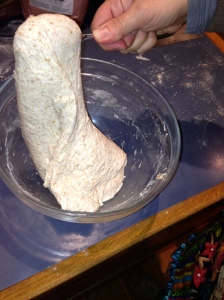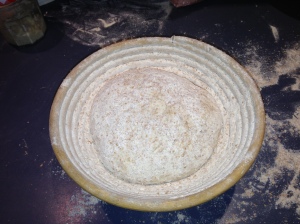Making Sourdough Bread using the Tartine folding method and Banneton basket
One of the books that really inspired me and made me want to learn more about Sourdough bread is ‘Tartine Bread’ by Chad Robertson. It is a beautiful book, the magnificent pictures and great writing, make you want to go straight to San Francisco to the Tartine bakery and smell the bread and the fresh northern Californian air . But if that’s slightly too far away for the moment, you could try out some of the recipes. Chad Robertson has developed a very successful way of making Sourdough bread that involves folding the dough every half an hour for the first three hours. (So you either need to be at home for three hours, or be going somewhere where you can take your dough with you. Today I needed to go in to town to do some shopping and I took the dough in the car and left it on the front seat and folded it when I needed to- it worked great- but you do get some funny looks). The folding really helps the dough develop a good structure quickly. In the book he describes the process of getting novice bakers to try the basic recipe and they all produce great looking loaves. So it is a very encouraging book for anyone who is just starting to bake. The actual recipes however, are all in very large quantities, in grams, and are incredibly detailed. Below is my simplified version- in cups and just for one loaf.
There are two other new things I am introducing you to in this blog:
- The first is using a banneton basket to prove the dough at the end. It holds the dough and helps it maintain its shape and also gives it those lovely rings round the bottom of the loaf ( a little hard to make out in the photo above I grant you). You can get bannetons from bakerybits.co.uk, if you live in the UK, but they should be fairly widely available on the net.
- The second is using a ‘lame’ ( a sharp bladed knife) to score the dough before you bake it, so that you can control where it splits. (you can also get lames from bakery bits) I scored this loaf using a cross hatch. If you don’t have a lame you can use a very sharp knife.
You will notice that the proportions of flour to water and use of the starter are pretty similar to my previous recipe for using your own Sourdough starter to make bread
Getting your starter refreshed and ready
If you have neglected your starter for a while (over a week) then a couple of days before you want to bake, start refreshing it. This is just the same method as you used when you were making your starter.
1. In the evening, throw ( or give) away all but around 1 tablespoon of starter. Add 1/4 cup of water and 1/2 cup of flour and mix well. Then leave at room temperature until the following evening.
2. Refresh again, just as you did last night, but this time just leave it until the morning.
3. Refresh again the next morning and by the evening you should have a lovely lively bubbly mass of starter ready to go. (If you don’t, just refresh it one more time)
Making the dough
Ingredients:
2 tablespoons of starter
2 cups strong white bread flour
1 cup of whole wheat bread flour (you can vary the flour combinations)
1 1/4 tsp salt
1 1/3 cups water
Method:
1. Put the starter in a mixing bowl and add the water and mix so that you break up the starter into smaller pieces
2. Add the bread flour and mix so that all the flour is hydrated and leave, covered with cling film or a shower cap, for 1/2 hour.
3. Add 1/2 teaspoon of salt and then fold 3 times, by pulling the dough up at one corner and folding it over and then doing this twice more
4. Add the rest of the salt and fold 3 more times and cover.
5. Then fold 3 times every half an hour for 3 hours and then leave it covered in the bowl for another 2 hours- or until it looks like it has become spongey and billowy
6. Turn it out on to a floured surface and stretch the dough to the right and then fold it back over itself and then do the same to the left and then from the upper edge and the lower edge, until you have an envelope parcel of dough
7. Then flip it over so that the smooth side is on the top and the folded seams are on the bottom.
5. Move your hands slowly pulling the dough gently downwards to create some tension over the top surface of the dough, whilst you are shaping it into a round ball.
6. Let the dough rest, covered with an upside down bowl, or some floured cling film, for half an hour. This is called ‘bench rest’
7. The dough should keep its basic shape and not turn into a sprawling pancake- if it does, then just fold it again and leave for more bench rest
8. Stretch and fold it again and flip it over and shape into a round ball and flour it.
9. Get your banneton and flour it inside and then put the dough in seam side up and smooth side down (if you don’t have a banneton yet then use a floured tea towel as in my previous recipes) and leave for half an hour
10. While the dough is rising, put a Le Creuset baking dish into the oven and pre-heat to 245 degrees c. for half an hour
11. Take the Le Creuset out of the oven with oven gloves, take the lid off and gently place the dough inside and then quickly score it with a cross hatch shape using a lame or a sharp knife
12. Put the lid back on and bake at 245 degrees for half and hour, then turn the oven down to 200 degrees and bake for a further 15 minutes with the lid off.
13. Take it out of the oven and let it cool on a wire wrack
4 responses to “Making Sourdough Bread using the Tartine folding method and Banneton basket”
Trackbacks / Pingbacks
- - September 19, 2013








Baked bread tonight using this method and found it made a wonderful improvement to end result. Loaves were baked in the gas barbecue as I don’t have a real oven. Thanks, will now check out your other ideas 🙂
See my loaves at http://aroundthemulberrytree.wordpress.com/2014/08/10/bbqd-bread-and-other-stuff/
Hi there, thank you for your post and detailed explanation. Just wondering if you had the original large quantity recipe. I am planning to bake for family members and friends for a large quantity in a sourdough. It’s a great challenge, specially the baneton technique and proofing them in the room temp etc.,Thank you very much. For your help it’s greatly appricated.